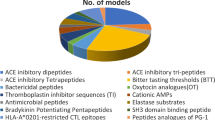Abstract
Quantitative structure-activity relationship (QSAR) modelling was performed on peptides derived from milk proteins that inhibit angiotensin-I-converting enzyme (ACE). Physico-chemical descriptors expressed hydrophobicity, size and charge of side chains of the two most external amino acids in N- or C-terminal position. Models were estimated with partial least squares regression and validated with full cross-validation. A relationship (R=0.73, p<0.001) was found between hydrophobicity and positively charged amino acid in C-terminal position, size of amino acid next to C-terminal position and ACE-inhibition of peptides up to six amino acids in length. When longer peptides were included the relationship between C-terminal structure and activity decreased, reflecting the likely influence by steric effects. No relationship between N-terminal structure and inhibition activity was found. These biochemical interpretations were supported by findings from QSAR-modelling using so-called z-scales developed by Jonsson et al. (1989, Quant. Struct.-Act Relat. 8, 204–209) for amino acids.


Similar content being viewed by others
References
Wyvratt MJ, Patchet AA (1985) Med Res Rev 5:485–531
Fitzgerald RJ, Meisel A (2003) Milk protein hydrolysates and bioactive peptides. In: Fox PF, McSweeney PLH (eds) Advanced dairy chemistry, vol 1, proteins, 3rd edn. Kluwer Academic/Plenum Publishers, New York, pp 675–698
Gobbetti M, Stepaniak L, De Angelis M, Corsetti A, Di Cagno R (2002) Crit Rev Food Sci 42:223–239
Esbensen KH (2001) Multivariate data analysis—in practice. Camo Process AS, Oslo, Norway
Jonsson JM, Eriksson L, Hellberg S, Sjöström M, Wold S (1989) Quant Struct–Act Relat 8:204–209
Hellberg S, Sjöström M, Skagerberg B, Wold S (1987) J Med Chem 30:1126–1135
Hellberg S, Eriksson L, Jonsson J, Lindgren F, Sjöström M, Skagerberg B, Wold S, Andrews P (1991) Int J Pept Protein Res 37:414–424
Martens M, Martens H (1986) Appl Spectrosc 40:303–310
Martens H, Naes T (1987) Multivariate calibration by data compression. In: Williams PC, Norris K (ed) Near-infrared technology in the agricultural and food industries. Assoc Cer Chem, St. Paul, pp 57–87
Sollie LA (2003) Bioactive peptides in fish. MSc Thesis, Agricultural University of Norway
Martens H, Martens M (2000) Food Qual Pref 11:5–16
Cheung HS, Feng-Lai W, Ondetti MA, Sabo EF, Cushman DW (1980) J Biol Chem 255:401–407
Ondetti MA, Cushman DW (1982) Ann Rev Biochem 51:283–308
Hopp TP, Woods KR (1981) Proc Natl Acad Sci USA 78:3824–3828
Kyte J, Doolittle R (1982) J Mol Biol 157:105–132
Cheftel JC, Cuq J-L, Lorient D (1985) Amino acids, peptides and proteins. In: Fennema OR (ed) Food chemistry. Marcel Dekker Inc, New York, pp 245–367
Acknowledgements
This work was funded by the Norwegian Research Council through project “Proteolysis in Foods: Quality and Biological Functions”.
Author information
Authors and Affiliations
Corresponding author
Rights and permissions
About this article
Cite this article
Pripp, A.H., Isaksson, T., Stepaniak, L. et al. Quantitative structure-activity relationship modelling of ACE-inhibitory peptides derived from milk proteins. Eur Food Res Technol 219, 579–583 (2004). https://doi.org/10.1007/s00217-004-1004-4
Received:
Revised:
Published:
Issue Date:
DOI: https://doi.org/10.1007/s00217-004-1004-4




